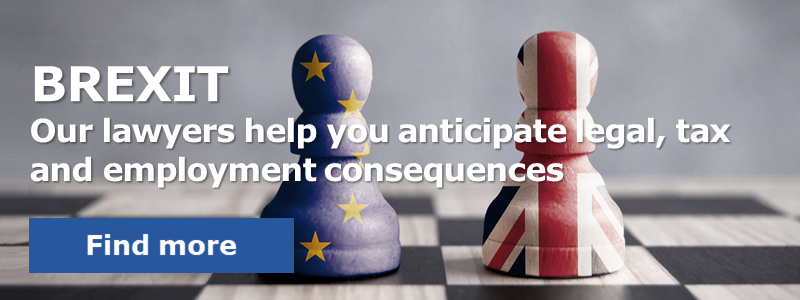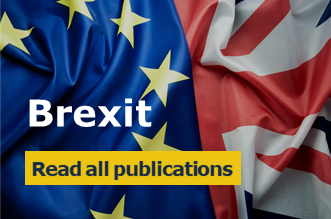Ten days from the official date of Brexit, it remains unlikely that the UK will leave the EU with or without a deal. Indeed, after excluding the assumption of an exit without an agreement from the European Union (EU) on March 13, and having rejected for the second time, the Exit Agreement negotiated by Prime Minister May, the day before, the British Parliament voted on March 14, for a short postponement of the exit date, probably until the end of June 2019, and for a new vote on the Exit Agreement.
In its current version, the Exit Agreement between the EU and the UK, provides for a transitional period until 31 December 2020, during which the current legislation would continue to apply in the UK and to the continuity of the EU trademark registrations and the registered Community designs, without any formality and extra costs to the holder, including where such rights have been obtained through the Madrid system for trademarks and the Hague Convention in respect of designs.
However, will this agreement hold? Indeed, after having already voted against twice, it does not seem very likely that the Parliament will now vote in favor, even if it is subjected to great pressure from the government.
Under these circumstances, the scenario of a hard Brexit, i.e. a Brexit without an exit agreement, is no longer a view of the imagination but becomes the most likely scenario.
Of course, Brexit does not have any impact on the protection of trademarks and designs obtained by the national route or the designation of the UK in an international application, or UK patents extended through the EPO.
These are national titles. However, a hard Brexit will have a greater or lesser impact on all IP rights and mainly on trademarks and designs.
Trademarks and designs
A hard Brexit will simply mean that as the exit date, the UK will find itself in the position of a third party to the EU and vice versa.
Regarding substantive law, all the European directives governing trademarks and designs, including the directive 2015/2436 which was to be transposed into national law by 14 January 2019 have been implemented and are part of the national law. Moreover, concerning European Regulations, since they are directly applicable, we can say that the rules governing the substance of UK law in these matters, are identical to other Member States national laws and no important changes are expected in the nearly times.
Nevertheless, immediately after the exit date, European Directives and Regulations in preparation and a fortiori, new Directives and Regulations will no longer have any effect in the UK, which will also cease to be covered by any new EU trademark application and Community design registration.
EU registered Trademarks and Community registered designs: With the planned date for the UK’s departure getting closer, the Parliament has adopted recently a new guidance as to how a no-deal Brexit might impact the local trademark and design law (The Trade Marks (EU Exit) Regulations 2019 (https://www.gov.uk/government/publications/changes-to-trade-mark-law-if-the-uk-leaves-the-eu-without-a-deal/changes-to-trade-mark-law-in-the-event-of-no-deal-from-the-european-union).
This new regulation confirms that at the exit date, 29 March 2019 or eventually a new one, if the UK and the EU so agreed, all owners of EU trademark registrations and Community design registrations will automatically acquire a comparable UK right. No fee will be payable, and no positive step is required from the owner of the EU trademark and Community design registrations.
The cloned parallel rights will keep the same registration number as well as the same filling and priority date. In addition, the new created UK rights will share the same renewal date.
There are around 1.3 million EU trademarks and 600,000 Community designs which will be cloned in the UK at the exit date.
An important point that has been clarified by the new law, concerns the renewal of the existing EU trademarks and Community designs. Where such registrations have a renewal date with falls within the next six months after the exit date, the corresponding UK registration will carry the same renewal deadline. Even where the EU registration has already been renewed before the exit date a further UK renewal will be necessary to maintain the corresponding UK registration.
The new regulation also provides a mechanism to enable the owner of an EU trademark registration or a Community design registration, to waive the creation of the equivalent UK right in certain limited circumstances (Opt-Out). This is not be possible if the EU registered right has been used in the UK, or if it has been assigned or licensed, if it has been the subject of any other agreement or it has had litigation based upon it.
In any event, the cloned UK trademark and design registrations, will be fully independent UK trademarks or UK registered designs i.e. they can be assigned, licensed, renewed or challenged separately from original EU registrations. Furthermore, in the case of trademarks, to be maintained, after the exit date, they must be used in the UK while use in the EU will continue to be considered in assessing serious use during the five-year period preceding that date. In other words, the cloning process does not create a new legal situation with respect to trademarks that are subject to an obligation of a serious use but simply prolongs the previous situation.
Likewise, as from the date of the Brexit day, the EU route will no longer be possible to protect a trademark or design in the UK, but it will have to be done through a national application or the Madrid Protocol or the Hague Convention for designs.
Pending EU trademark and Community design application: Comparable UK rights will only be created for EU trademark registrations and Community design registrations. For pending applications on the exit day, it will be possible within nine months of this date to apply to register a UK trademark or design with the same filing and priority dates as the corresponding European applications. To claim the earlier EU filing or priority date, the corresponding UK application should cover the same goods or services. The new application is subject to the payment of the same official fees as for a regular UK application.
It is estimated that it will be approximately 85,000 pending EU trademark applications and around 20,000 new design applications at the exit day.
A certain number of gray areas remain with regard to these new applications but one thing seems certain. The re-filing process opens a completely new proceeding totally independent of the EUIPO procedure. Regarding trademarks, it means that the UKIPO will proceed to a full examination of distinctiveness and the application will be published to allow third parties to file oppositions, no matter at what stage the European application was at the time of the exit day.
As Brexit is a known fact since the referendum of 23 June 2016, many trademark and design holders have changed their policies and started since then to cover the UK through the Madrid system in parallel with the EU applications. That means that on the exit day, these holders may own a UK trademark and an EU application for the same trademark. In such a scenario, these owners may have an interest in waiving this tool to avoid any potential objection and possible opposition against the new application which could, in turn, put the identical registration in a risk.
Abandoned or Refused EU trademarks: An EU trademark registration or application that has been refused or withdrawn may be converted into a national UK right. This is subject to certain conditions, and provided that the application for conversion is submitted to the EUIPO within three months of the EU right ceasing to have effect. Where conversion takes place, the resulting national right will inherit the earlier filing/seniority and/or priority date held by the EU right.
On exit day, the EU Register may contain a small number of rights which, whilst being either refused or withdrawn, are within the three-month period provided for the purposes of requesting conversion into a national right. Because of their status on exit day, these EU rights will not be included in the UK comparable trademark but still enjoy the right to conversion into a UK trademark.
The new mechanism applies to these abandoned or refused trademarks.
Unregistered Community designs: The unregistered Community design mechanism which applies to designs which have come to existence through a first disclosure to the public in the EU before the exit date, and are still in period of the three years protection, will continue to be protected in the UK for the remainder of their term of protection as “continuing unregistered design”.
Moreover, since the EU’s unregistered design right will no longer apply in the UK after the Brexit date, the Government is creating a mirror right to ensure that equivalent protection exists in the country after that date. The new tool is called the Supplementary Unregistered Design and would apply to designs that have been disclosed in a way that could have become known in the normal course of business to the circles specialised in the sector operating within the UK, the EU, Hong Kong, New Zealand, and various other smaller countries. The system will work the same way as the current unregistered community design regime.
Exhaustion of rights: The UK is currently part of the European Economic Area (EEA) exhaustion scheme meaning that IP rights are considered exhausted once the product incorporating this right, has been put on the market anywhere in the EEA with the right holder’s permission. After the Brexit, the UK will likely continue to apply the EEA exhaustion scheme.
Patents
As the UK is a member of the European Patent Convention (EPO), which is not linked to an EU Member State status, Brexit will not have much impact on patents. The European Patent, which is a bundle of national patents accessed through a central application process, will still be available through the European Patent Office, to protect inventions in the UK.
However, the supplementary protection certificate (SPC) which allow, under certain conditions, to extend the term of protection of a pharmaceutical patent beyond the usual 20 years, may be affected by the Brexit. SPC is governed by an EU regulation that may not automatically apply after Brexit. If this is the case, and to ensure the protection granted by SPC after the Brexit, the UK could implement a national SPC equivalent right or opt into the European SPC regime if it becomes a member of the EEA.
However, the most important impact that Brexit may have on patents, is in the implementation of the Unified Patent Court (UPC). The UPC together with the Unitary Patent (UP) constitutes the biggest reform in the history of European patent law since the adoption of the EPO.
Indeed, the first pillar of the new system, the UP, was created by the adoption of an EU Regulation. In this context, it seems difficult to think that the UP could have effects on the territory of a non-UE member state such as the UK after Brexit.
And for the second pillar, the UPC, the agreement provides, on the one hand, that part of the Central Division would be based in London and, on the other hand, the ratification of the UPC Agreement from the UK is required before the UPC can come into effect. In view of this, it is not excluded that Brexit paralyzes the entry into force of the entire system. In addition, it is unclear whether it is even possible for the UK to ratify the agreement following Brexit and participate in the system after it ceases to be an EU Member State. Further delays with respect to the UPC appear inevitable.
Copyright and author’s right
The fundamental differences between insular copyright and continental author’s right, especially regarding the substance of the law itself, are certainly at the origin of the failure of all attempts to harmonize these matters, initiated by the European Commission.
Both copyright and author’s right in the EU, remain mainly national rights.
However, it is undeniable that after 46 years in the EU, the concept of copyright has evolved considerably towards a rapprochement of the continental author’s right system. In principle, these developments should remain after the Brexit.
Other remarks and recommendations
Beyond the mainly procedural aspects we have focused, Brexit will also have an impact on the day-to-day life of IP rights as well as in the management and enforcement of these rights.
Fight against counterfeiting: Because of their unitary character the existing Customs Applications for Action (AFA) created by the EU Regulation 608/2013 of 12 June 2013 will continue to remain in place after the exit day but only in relation to the UK. Therefore, the UK Government published a draft legislation identical to the European law and operating the same way
https://assets.publishing.service.gov.uk/media/5c7926efe5274a0ecd5f5af5/Proposed_Negative_SI.pdf
Licenses and Coexistence Agreements: Current licensing agreements, coexistence agreements and, more generally, all agreements by which IP rights holders organized the protection and exploitation of two trademarks, are very often based on scenario of an EU constituting a unitary territory including the UK. It is therefore necessary to review existing agreements to ensure that they are consistent with the new situation and the will of the interested parties, in the areas of the use of rights, royalties, settlement disputes, etc. and if necessary, to make the adjustments imposed by this event that is the Brexit.
Brexit is a new situation. Indeed, no Member State having already withdrawn from the EU, we are totally lacking benchmarks.
In any case, we are certain that new problems that no one has thought of, will arise in the field of IP rights, but also in all other fields. That is why we would have liked so much that, failing to be able to live together, the two parties agree on a beautiful divorce agreement!!!
Brexit: our lawyers support your business
Thanks to a multidisciplinary, tailored offer, our teams can support your adjustment to a hard Brexit and help you manage the challenges you face vis-à-vis the United Kingdom, against a changing and unstable backdrop.
On the same topic:









Social Media cookies collect information about you sharing information from our website via social media tools, or analytics to understand your browsing between social media tools or our Social Media campaigns and our own websites. We do this to optimise the mix of channels to provide you with our content. Details concerning the tools in use are in our privacy policy.